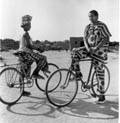






La
vie sur terre (Life on Earth) La
vie sur terre is one of the most searching and at the same time poetic
meditations on Africa at the beginning of a new millennium to have appeared
in any medium. It was conceived as part of 2000 Vue Par, a European television
series which invited ten outstanding independent producers to imagine
the last day of the present century in their own countries. Sissako's
specific challenge therefore was to make a film about the significance
of the start of the 21st century for people still struggling to enter
the 20th; in other words, to show Africa's simultaneous connection to
and isolation from modernity, our so-called Information Age. His solution,
the most innovative and critically admired of any of films in the series,
was to improvise a "fictional documentary" out of daily life
in Sokolo, his father's village in Mali near the southeastern corner of
Mauritania. He then overlaid these vignettes with readings from Aimé
Césaire, locating them within the poet's critique of the relationship
between metropole and periphery. Behind all of this, he weaves the melancholy
tones of the great Malian tenor, Salif Keita. La
vie sur terre is one of the most searching and at the same time poetic
meditations on Africa at the beginning of a new millennium to have appeared
in any medium. It was conceived as part of 2000 Vue Par, a European television
series which invited ten outstanding independent producers to imagine
the last day of the present century in their own countries. Sissako's
specific challenge therefore was to make a film about the significance
of the start of the 21st century for people still struggling to enter
the 20th; in other words, to show Africa's simultaneous connection to
and isolation from modernity, our so-called Information Age. His solution,
the most innovative and critically admired of any of films in the series,
was to improvise a "fictional documentary" out of daily life
in Sokolo, his father's village in Mali near the southeastern corner of
Mauritania. He then overlaid these vignettes with readings from Aimé
Césaire, locating them within the poet's critique of the relationship
between metropole and periphery. Behind all of this, he weaves the melancholy
tones of the great Malian tenor, Salif Keita.
At the outset, Sissako is mindful of Césaire's stricture: "Do not assume the sterile stance of a spectator/ For a screaming man is not a dancing bear." He brings the same ironic self-awareness to this film that he demonstrated in Rostov-Luanda. Sissako (or his alter ego Draaman) appears everywhere in the film riding through the town's maze of mud brick streets on his bicycle - although he does not seem at all deliberate about where he's going, looping back onto himself. Sissako deliberately avoids imposing a false chiliastic narrative on the quotidian life of Sokolo, by constructing his film out of loosely scripted fragments and incomplete story threads. Nothing is neat; life in Sokolo is not "Y2K compliant." The film's dominant
visual motif is leisurely, even lugubrious shots of anonymous people
making their way slowly across the boundless savanna or through the
dusty streets. Sissako here is reminding us that for much of the world's
population "life on earth" is still conducted on foot, by
donkey cart or bicycle. Life in Sokolo is a far cry from the 21st century
trumpeted in the West where the Information Superhighway moves everything
in nanoseconds. This is the terrestrial reality which too often is ignored
in virtual reality. Sokolo's desperate attempts to maintain contact with the rest of the world are focused and frustrated at the local post office, the busiest place in town and site of its sole telephone. Symbolically, when Sissako/ Dramaan finally receives a call from Paris, the postmaster must hobble across town on crutches to fetch him. "Reaching people is always a matter of luck," the postmaster comments - but he may also be speaking for the filmmaker about the likelihood of successful cross-cultural communication. In an interview Sissako has said, "More important than the message itself is the act of wanting to communicate." Nana, a beautiful young woman has waited all day to get a call through to her boyfriend Bai in a nearby town. (Sissako "discovered" her character when she accidentally bicycled into a shot and then incorporated her into his improvised script.) Exasperated, she gives up on telecommunications, simply gets on her bike and disappears in the film's final shot into the distance in pursuit of her own destiny. Throughout the film her evasions of the director's mild flirtations could be interpreted as Africa's refusal to abandon an independent course to be part of anybody's story. In La vie sur terre, Sissako is not simply asking that we remember to include an impoverished, "backward" Africa in our overview of the world at the turn of the 21st century. Nor is he simply lamenting the immense and growing technological inequalities between North and South. He is insisting that Africa has a role of its own to play in the unending work of human transformation. "Europe has fed us lies," Césaire says, "For it is not true that Man's work is done." "You know it
is not hatred of other races Africa's real potential cannot be filmed in the dusty streets of Sokolo, nor will it be prefigured in the avenues of Paris or New York, it can only be discovered in the deepest aspirations of the poet, the filmmaker and the people. Sissako through this film has added Sokolo's voice, however distant and distorted by static, to a continuing conversation about what the 21st century will become. |
"A movie
of uncommon grace and delicacy ...a compelling lament for a beloved
country impoverished by colonialism and stranded in time. " "Luminous,
poetic, reflective and pointed." "A poignant
tale of the conflict between old and new, of men and women reaching
out to each other in a changing world." Director: Abderrahmane
Sissako Mali, 1998
Video Purchase: $195
|